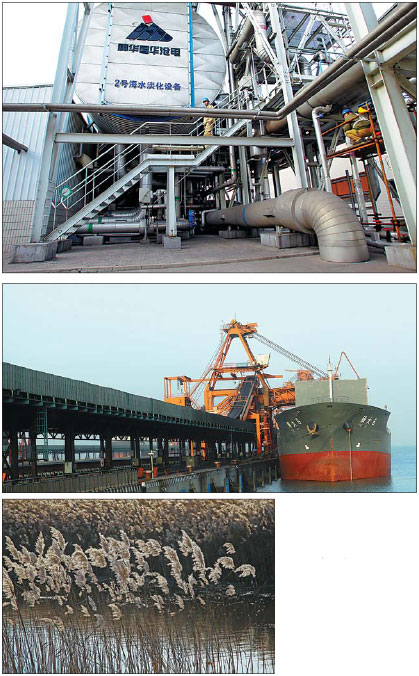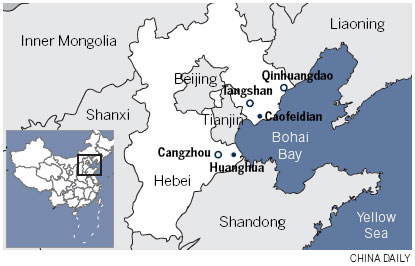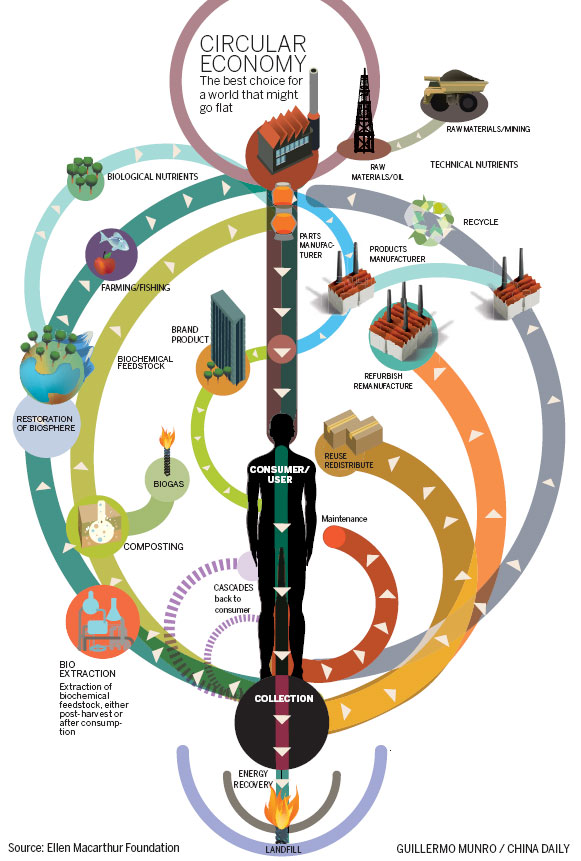|
|

Top: Workers check seawater desalination equipment at Shenhua Group Co in Cangzhou, Hebei province. Middle: Huanghua Port in Cangzhou. Left: The wetland in Caofeidian near Bohai Bay. Below: Caofeidian is being developed into one of China's largest ports. Photos by Zou Hong / China Daily |
|

Infrastructure development is sparking an upturn in the economy at Caofeidian, an emerging industrial zone in Hebei province. Xinhua |
A vision from the past takes concrete shape to secure the future, Wang Hao, Du Juan and Pei Pei report in Tangshan and Cangzhou, Hebei province.
'A great port will be built in northern China. It is my and my compatriots' idea to develop the port in a limited amount of time and make it as big as New York," says a line in Methods and Strategies of Establishing the Country, published in February 1919.
The author of those words was the revolutionary Sun Yat-sen (1866-1925), who wrote the Methods seven years after he declared the founding of the Republic of China and became its first president. At the time, China was divided by warlords and hard-pressed by poverty, but still Sun envisioned the port and detailed its location.
He wrote, "between Qinhuangdao and Dagukou", stands Caofeidian Port of Tangshan in North China's Hebei province. Originally an island of no more than 4 square kilometers, the port has expanded to cover an area of 210 sq km since marine reclamation work started in 2003.
More than 100 km south of Caofeidian, also on the coast of Bohai Bay, Huanghua Port, built in 1984, has emerged as China's second-largest coal exporting port. Its expansion has been rapid because Shenhua Group Co, China's biggest coal producer, has spent the past decade building its own port in Huanghua.
The two rapidly expanding ports are expected to be the drivers of an economic takeoff in Hebei, which encircles Beijing and Tianjin. The populous province provides the two municipalities with numerous resources and helps to shoulder their development costs.
The ports are also a demonstration of China's progress in the field of sustainable development. Projects, such as Shougang United Iron and Steel Co, which moved to Caofeidian from suburban Beijing ahead of the Beijing Olympics in 2008, have embraced the concept of the "circular economy" for the benefit of the environment.
Wang Zhongmin, general manager of Tangshan Caofeidian Shiye Port Co Ltd, has worked at the port for nine years. "I arrived when the infrastructure construction for the port began at the end of 2003. Soon, we were building a port for iron ore. It was urgently needed," he said.
At Caofeidian, five or six cargo vessels, each with the capacity to carry 200,000 metric tons of iron ore, are unloaded every day.
Analysts believe that the port's location means it has more advantages and greater potential than Qinhuangdao.
In 2011, construction was completed on the first and second phrases of iron ore ports, the first phrase of a coal port, crude oil and bulk terminals with a total turnover volume of 170 million tons, according to the Caofeidian local government.
The port will have a capacity of 300 million tons and turnover volume of 200 million tons by the end of the year, said Yang Jie, chief executive of Caofeidian district.
Yang said the port will eventually reach a total capacity of 500 million tons, becoming one of the largest ports in the world, when the projects are completed. Coal is the most important of the projects because of its impact on the energy supply in Southeast China.
On Nov 5, a coal port owned by SDIC Caofeidian Port Co, a subsidiary of the State Development and Investment Corp, was put into use. Construction work, including 10 coal berths and 18 store yards with total capacity of 8.37 million tons, started in 2006. The coal port alone has an annual capacity of 100 million tons.
The second phrase of Caofeidian coal port, which garnered investment of 5.4 billion yuan ($857 million), will be put into use in the first half of 2013 and a third coal port, with investment of 5.2 billion yuan, is still under construction, according to Yang.
"The planned coal capacity of Caofeidian will reach 350 million tons," she said.
There are a number of steel companies, including Hebei Iron and Steel Group Co and Shougang United Iron and Steel Co, in the province, and the coal and iron ore ports provide easy access to the fuel and raw materials they require, which helps to reduce costs.
"Importing iron ore at Caofeidian port has greatly helped nearby steel mills to reduce their logistics expenses," said Wang. "Plus, the port helps to deliver coal from the north, China's major coal producing area, to the southern provinces which are big consumers of electricity."
Both of China's major coal mining areas, Shanxi province and the Inner Mongolia autonomous region, neighbor Hebei. Coal and related products are transported to Qinhuangdao and Caofeidian ports and then distributed in the south of the country.
Qinhuangdao had a turnover of about 227 million tons of coal by mid-November, according to statistics from JYD Online Co Ltd, a bulk-commodity consultant in Beijing.
"The cost of transporting coal from the mining areas to Caofeidian is lower than to Qinhuangdao," said Dai Bing, director of the coal industry information department at JYD. "Caofeidian also has a greater number of highways than Qinhuangdao."
The Chinese government has encouraged the increased importation of fossil fuels, such as coal, and Caofeidian's location is more convenient for coal exporters overseas compared with Qinhuangdao port, he said.
Based on the port economy, the district will increase its efforts to establish trading centers for six major commodities, including coal, steel, iron ore and gas, which are intended to provide services for Chinese and foreign companies to start businesses in the region, according to the local government.
Meanwhile, next year will see construction start on an oil-refining project with an annual capacity of 10 million tons, a seawater desalination project with planned daily output of 1 million tons, and two power plants.
Circular economy
In industrial development, the environment and energy-reduction are always eye-catching factors, and become a problem for local authorities.
"For Caofeidian, one of the first operations in China's national circular economy demonstration area, economic growth and environmental protection are equally important," said Yang.
The key concept, the circular economy, focuses on the use of "waste" from one facility's manufacturing process, including energy and water, as input material for another facility. The idea is to realize a collective benefit larger than the sum of the individual benefits.
Yang said the theory behind Caofeidian's circular economy is that the concept is applied across a range of industries.
Shougang United Iron and Steel Co, a company with annual crude steel production capacity of 9.7 million tons, is a prime example of how the process works: "We use the coal gas, which is the waste from the steel-making process, for our power plants during electricity generation," said Yang Chunzheng, Shougang United's deputy general manager. "Then, the electricity can be used back in the steel mills."
Despite its huge appetite for electricity, the company not only generates 98 percent of its own power, but it can even offer some to the national grid on occasion, according to Yang.
"Meanwhile, seawater is used for once-through cooling in power plants and is then reused in the steel-making process after being desalinated.
"The steel slag will be delivered to cement plants or construction sites for use as a raw material."
In addition to the circular economy, the company spent 7 billion yuan, roughly 11 percent of its total investment, on environmental protection between 2007 and 2011, he said.
Wang Shuzhong, deputy head of the energy department, said,"You will not smell anything weird or notice any irritants in our factory."
Steel-related businesses, such as automobile manufacturers, are now opening factories in the district to reduce logistics costs.
In fact, Shougang will increase its output of steel sheets for automobile use in the next year as it follows the trend. "Our output of automobile-use steel products will increase by more than 60 percent to 500,000 tons in 2013," said Yang.

Optimistic outlook
Meanwhile, Huanghua port, China's second-largest coal exporting port, is located in Cangzhou city, 200 km from Beijing.
Despite the downturn in global trade, the port still achieved turnover volume of 115 million tons in the first 10 months of 2012 and it is expected to reach 118 million tons for the whole year, said Zhao Zhenqing, director of the Cangzhou Bohai New Economic Development Bureau.
"The port's economy is heavily reliant on international trade, therefore the European debt crisis and China's economic slowdown have made this a really tough year," he said.
The port mainly transports resources such as iron ore and coal for steel companies and power plants. The annual turnover volume of iron ore is about 18 million tons, more than half of which comes from foreign countries, including Malaysia and Indonesia, according to Zhao.
In 2011, the port had a total turnover volume of 116 million tons, with coal accounting for roughly 100 million tons.
Shenhua Group Co, China's biggest coal mining and trading company, built its own port in Huanghua because of the area's convenience for coal producing regions such as Shanxi and Inner Mongolia.
The company's completed first- and second-phase coal ports have a combined annual capacity of 70 million tons.
Construction of the group's third coal port, which has a capacity of 50 million tons, was completed in late November, raising the port's annual turnover of coal by 50 percent.
"As an important exit point for coal, the completion of the third phrase of the port will help to ensure the supply of fuel for power plants in southern China," Zhao said.
Construction of the fourth phase is scheduled for completion by the end of 2014, which will make Huanghua China's biggest coal port, according to Liu Fengliang, head of the production management center of Shenhua Huanghua Port Co.
"There are 1,700 sq km of land available for use in the port area at Cangzhou. That's attracted a lot of investors to the area," said Zhang Yong, a local government official.
At present, China Petroleum and Chemical Corp, China National Petroleum Corp and China National Offshore Oil Corp all have refining projects under construction, with a combined annual capacity of 21 million tons.
"We provide supportive policies to attract more investors," said Chen Tailong, director of Cangzhou Bohai New Area Management Committee Office.
He added that the projects currently under construction or discussion will require total capital of 901.3 billion yuan.
In Cangzhou, the major industries include petrochemicals, equipment manufacturing, new materials, new energy and logistics.
To attract more investors from home and abroad, the local government will invest 200 million yuan and provide around 67 hectares of land to build 10 national laboratories for research and development into industrial upgrading in different sectors.
"We hope that investors will discover opportunities and have the confidence to open their businesses here," said Chen. "As a local government, we try to provide better services to attract talent and to ensure they can always find a place in the industrial chain to make a profit or display their abilities."
In addition to economic development, Cangzhou is also working hard to build an eco-city, with 28 sq km of parks and woodlands.
The forest coverage has risen to 43.7 percent. That's equal to some of the best neighborhoods in San Francisco, the city in which Sun Yat-sen spent years preparing to change China, and where his statue still stands today.
Contact the reporters at dujuan@chinadaily.com.cn and peipei@chinadaily.com.cn


(China Daily 12/11/2012 page6)
|